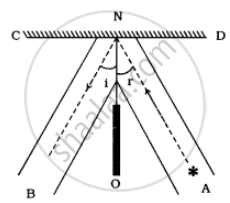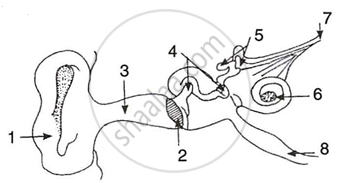Advertisements
Advertisements
प्रश्न
Verify experimentally the laws reflection of sound.
उत्तर
The laws of reflection are:
- The angle in which the sound is incident is equal to the angle in which sound is reflected.
- Direction of incident sound, direction of the reflected sound and the normal are in the same plane.
Reflection of sound

Take two metal tubes A and B. Keep one end of each tube on a metal plate as shown in figure. Place a wrist watch c at the open end of the tube A and interpose a cardboard between A and B. Now at a particular inclination of the tube B with the cardboard, ticking of the watch is clearly heard. The angle of reflection made by the tube B with the cardboard is equal to the angle of incidence made by the tube A with the cardboard.
For example, if the angle of incidence is 20° on the left side of a protractor (see figure arrangement), the angle of reflection at which we are able to hear the sound clearly will also be at 20° on the right side of the protractor.
∴ ∠ i = ∠ r ➝ verifying Law I
We will also further observe that pipe 1, pipe 2 i.e, the incident ray, reflected ray and the normal lie on the same plane, verifying law II.
APPEARS IN
संबंधित प्रश्न
Explain the following:
Mechanism through which a sound produces a nerve impulse in the inner ear.
A fluid that occupies the larger cavity of the eye ball behind the lens is
___________.
Differentiate between members of the following pair with reference to what is asked in bracket.
Semi-circular canal and cochlea (Senses perceived)
Where is the oval window located? Briefly mention its function.
How could you convince a small child that when you speak, it is not necessary for air to travel from you mouth to the ear of listener?
Mention, if the following statement is True or False
Deafness is caused due to the rupturing of the pinna.
X is known as the balancing organ of ear.
Choose the correct option for X.
Categorise the following parts under (i) external, (ii) middle and (iii) internal ear.
Ear drum, hammer, pinna, cochlea, anvil, stirrup, eustachian tube, tympanum, oval window, semi-circular canals.
Where are the following located?
Eustachian canal
The figure given below shows the principal parts of a human ear. Study the diagram and answer the following questions.
 |
- Label the parts 1 to 8.
- State the role of parts 6, 7 and 8.
- Why is it harmful to use a sharp object to remove ear wax? Mention the number and name of the part involved.
